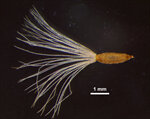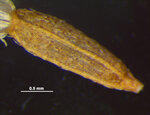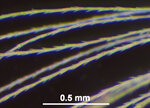Taxonomy
Symphyotrichum novi-belgii (L.) G.L.Nesom, Phytologia 77: 287. 1995.Common synonyms
Aster novi-belgii L. Sp. Pl. 2: 877. 1753.Common name
New York aster, Michelmas daisy
Description
Propagule or dispersal unit is the fruit with pappus. Fertile part 1.8-2.6 mm long, 0.3-0.8 mm wide, in side view widest in upper part (obovoid) or widest in the middle, +/- straight, the upper (apical) end narrowing, in cross-section flattened or angular (prismatic), basal scar (carpopodium) pronounced and well-differentiated, central, beak (=thinner sterile stalk between seed and pappus) absent, wings absent, fruit surface light brown or straw, smooth (except at cellular level), with no hairs (glabrous) or simple straight hairs, thickened margin absent, longitudinal ribs present, 3-5, their surfaces smooth, with no hairs (glabrous) or simple straight hairs.
Pappus type bristles / hairs, pappus elements all +/- similar, up to 4-6 mm long, in one row, pappus elements numerous, persistent, rarely elements falling off individually, the individual bristles rough / serrated (barbellate), +/- equal width along length, white / translucent.
Notes: Unfortunately, the Symphyotrichum species cannot be differentiated in this fruit key.
Ecology
Perennial herb, fruits wind-dispersed. Temperate regions. Garden escape.
Native range
Canada, United States.
Introduced range
Europe, Japan, Australia, New Zealand.
Past interceptions (Australia): origins
Other or unidentified species of the genus from Colombia, Ecuador, Spain, Italy, China, Korea, Japan, Thailand.
Past interceptions (Australia): commodities
Other or unidentified species of the genus in/on containers, cut flowers, new vehicles, steel, and soil.




